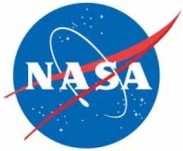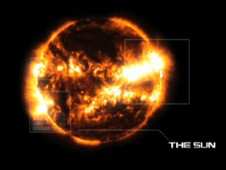STEREO Probes Continue To Dazzle
 Twin NASA spacecraft have provided
scientists with their first view of the speed, trajectory, and
three-dimensional shape of powerful explosions from the sun known
as coronal mass ejections, or CMEs. This new capability will
dramatically enhance scientists' ability to predict if and how
these solar tsunamis could affect Earth.
Twin NASA spacecraft have provided
scientists with their first view of the speed, trajectory, and
three-dimensional shape of powerful explosions from the sun known
as coronal mass ejections, or CMEs. This new capability will
dramatically enhance scientists' ability to predict if and how
these solar tsunamis could affect Earth.
When directed toward our planet, these ejections can be
breathtakingly beautiful and yet potentially cause damaging effects
worldwide. The brightly colored phenomena known as auroras -- more
commonly called Northern or Southern Lights -- are examples of
Earth's upper atmosphere harmlessly being disturbed by a CME.
However, ejections can produce a form of solar cosmic rays that can
be hazardous to spacecraft, astronauts and technology on Earth.
Space weather produces disturbances in electromagnetic fields on
Earth that can induce extreme currents in wires, disrupting power
lines and causing wide-spread blackouts. These sun storms can
interfere with communications between ground controllers and
satellites and with airplane pilots flying near Earth's poles.
Radio noise from the storm also can disrupt cell phone service.
Space weather has been recognized as causing problems with new
technology since the invention of the telegraph in the 19th
century.
NASA's twin Solar Terrestrial Relations Observatory, or STEREO,
spacecraft are providing the unique scientific tool to study these
ejections as never before. Launched in October 2006, STEREO's
nearly identical observatories can make simultaneous observations
of these ejections of plasma and magnetic energy that originate
from the sun's outer atmosphere, or corona. The spacecraft are
stationed at different vantage points. One leads Earth in its orbit
around the sun, while the other trails the planet.
 Using three-dimensional
observations, solar physicists can examine a CME's structure,
velocity, mass, and direction in the corona while tracking it
through interplanetary space. These measurements can help determine
when a CME will reach Earth and predict how much energy it will
deliver to our magnetosphere, which is Earth's protective magnetic
shield.
Using three-dimensional
observations, solar physicists can examine a CME's structure,
velocity, mass, and direction in the corona while tracking it
through interplanetary space. These measurements can help determine
when a CME will reach Earth and predict how much energy it will
deliver to our magnetosphere, which is Earth's protective magnetic
shield.
These ejections carry billions of tons of plasma into space at
thousands of miles per hour. This plasma, which carries with it
some of the magnetic field from the corona, can create a large,
moving disturbance in space that produces a shock wave. The wave
can accelerate some of the surrounding particles to high energies
that can produce a form of solar cosmic rays. This process also can
create disruptive space weather during and following the CME's
interaction with Earth's magnetosphere and upper atmosphere.
"The new vantage point of these spacecraft has revolutionized
the study of solar physics," said Madhulika Guhathakurta, STEREO
program scientist at NASA Headquarters in Washington. "We can
better determine the impact of CME effects on Earth because of our
new ability to observe in 3D."
STEREO is part of NASA's Solar Terrestrial Probes Program in
NASA's Science Mission Directorate in Washington. The program seeks
to understand the fundamental physical processes of the space
environment from the sun to Earth and other planets.
As ANN reported earlier this week, scientists
also hope STEREO may also establish how Earth's moon came into
being.
 ANN's Daily Aero-Linx (06.29.25)
ANN's Daily Aero-Linx (06.29.25) ANN's Daily Aero-Term (06.29.25): Gross Navigation Error (GNE)
ANN's Daily Aero-Term (06.29.25): Gross Navigation Error (GNE) Classic Aero-TV: Anticipating Futurespace - Blue Origin Visits Airventure 2017
Classic Aero-TV: Anticipating Futurespace - Blue Origin Visits Airventure 2017 NTSB Final Report: Cirrus SR22
NTSB Final Report: Cirrus SR22 Airborne Affordable Flyers 06.26.25: PA18 Upgrades, Delta Force, Rhinebeck
Airborne Affordable Flyers 06.26.25: PA18 Upgrades, Delta Force, Rhinebeck




